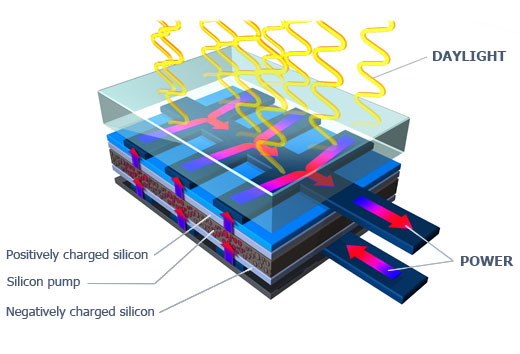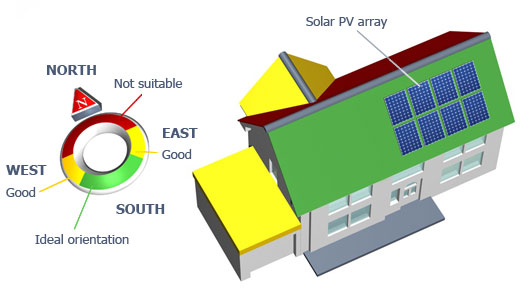Guide to Solar
There are many things for you to consider when you are thinking about investing in solar PV for electricity production. Our easy to use guide takes you through step-by-step.How solar cells work
A solar PV panel (sometimes called a module) consists of a number of photovoltaic cells joined together to create a module – this is the basic building block of a solar PV system. A number of modules are connected together to create an array and the size of the array makes up the kWp (kilowatt peak) size that can be fitted on your roof. This kWp solar PV system size dictates the output of the system under Standard Test Conditions. The various module technologies have different expected annual outputs in the UK.
Put simply, when exposed to light the cells generate electrical energy (DC current), which is conducted away to an inverter to create mains electricity (AC current). This can then be used in and around your property at the time your array is generating it.
PV cells are mainly manufactured from silicon, a semi conducting material, which is also found in many modern devices such as PCs and TVs. PV cells are either classified as a form of crystalline, thin film or a combination of these two technologies. It is the combined form of cells that produce the most efficient solar PV module commercially available.
Not all solar PV cells and solar panels are the same quality. A solar PV system is a long term investment and you need to be sure of the product you are buying as it should be generating solar electricity at its optimum for many decades. The diagram below shows how a typical solar PV cell works:

Solar PV panels - types of cells
Solar PV systems are sized in kWp (kilowatt peak), which is a measure of their maximum output in Standard Test Conditions. However, in the UK, we don’t see much in the way of ideal conditions and so a system needs to be considered in terms of its electrical output.
This output is measured in kWh (kilowatt hours), which is the same measurement as the electrical units shown on an electricity bill.
Different panels and technology generate various outputs per kWp albeit we need to use a generic Government standard formula which can over inflate and under inflate the actual annual output depending on the type of panel, location, orientation, inclination etc. We will advise you of the differences in PV panel technology.
There is a lot of conflicting information written on various websites regarding the efficiency of PV panels. This is mainly due to how the manufacturer’s give their information, which can be rather deceptive unless you know what their data represents. To give you an overview of efficiencies, tolerances etc we recommend you read our short Jargon Buster document we have put together to help you make an informed decision.
PV panels can be installed on top of the existing roof covering, semi-integrated into the roof covering with conventional tiles around or fully integrated using either solar tiles or the larger solar panels. Chelsfield Solar will advise you of the best technology for your property once we have details of your specific project.
Suitability
There are a number of factors that need to be considered when thinking about the suitability of a solar PV installation for your property or building.
The orientation of the building will effect the amount of solar PV energy your system can generate as well as the size of the roof space that is both available and suitable for installation.
The following sections deal in more depth with these issues.
Orientation
Southerly facing aspects are optimum and the drawing below shows how the orientation will have an effect on the output of a solar PV system. This assumes an un-shaded pitched roof of 30° to 40° (standard pitched roof).
To check the orientation of your roof, two useful web sites are Google Maps or Bing which are both free.
Size of roof
The size of your roof will dictate how much solar PV will fit on it and therefore how much electricity you will be able to generate.
Different PV technology requires various areas but for a system connected to the national grid, the smallest area a PV system will take up is approx 7m2

Positioning
Penetrations such as chimneys, pier walls, dormers, veluxes and soil vent pipes will have an effect on where the PV could be positioned.
Depending on the orientation of your roof, shading from chimneys and dormers can be significant so we tend to avoid the areas directly beside these as shading may substantially reduce the overall output of a solar PV system.
Pitched Roofs
PV panels or tiles should not be placed right up to the hip, ridge or eave of a roof. This is due to a number of reasons such as rain run-off should still be able to fall into the gutter (retrofit systems sit slightly higher than the roof tiles) and wind turbulence is greater at the roof edges and sides. The pictures below give an indication of the size of roof and how PV should be positioned. However, there are solar pnael products available that sit flush with your conventional roof tile; please talk to us about your project to confirm it would be suitable for this option.
Flat Roofs
There are a number of different methods of securing a PV array to a flat roof but it is generally easier to install to a new flat roof or one that is being re-weatherproofed.
One method is to build the PV array on an ‘A-frame’, which would be secured to the roof structure. For an existing flat roof, access may be required from the underside, which may cause an issue if there is a plaster boarded ceiling as small access holes would need to be made in it. Fixing pads would need to be installed on top of the roof and weatherproofed by your roofer – we will provide details and drawings showing what is required. We would then install the PV array to the pads.
Another method of fixing to a flat roof that does not require penetrating the existing covering is to have a ballasted system but we would need confirmation that the flat roof is capable of taking the additional ballasted weight, which is approx 80kg per unit (one unit per PV panel).
Dimensions
Chelsfield Solar can provide you with an accurate initial estimate for designing and installing solar PV panels.
We can normally estimate the measurements from the satellite images of your building or from the photo you send of the most southerly facing aspect. The more information we can initially ascertain, the more accurate the initial estimate will be.
If your property has had an extension recently it may not show on some of the satellite programmes and this may affect the solar PV system options. However, we always confirm details from carrying out a no-obligation survey after you have had sight of the initial options so we would then take this into account.
Electrical
The electrical component of the installation is covered by Part P of the Building Regulations. Chelsfield Electrical Ltd (parent company of Chelsfield Solar) are NIC/EIC approved contractors, which means we will arrange Building Control Part P approval on your behalf.
Structural The structural side of Building Regulations (Part A) relates to the weight, which is to be added to the roof in comparison to the weight of the roof covering. Following a site survey, we carry out a basic calculation of this ratio to check the system is within the relevant guideline. However, if you have any concerns you should contact the council building control department or an independent structural surveyor.
Planning Permission
Generally you do not need to obtain Planning Permission for the installation of solar panels. There are some instances where you will though e.g. Listed Buildings, highway facing if installing on a wall in a Conservation Area (pitched roofs are permitted in Conservation Areas) or if exceeding the highest point of the roof.
Inverters
Inverters convert DC electricity made from the solar PV panels into usable AC electricity for your property. There are many options available including conventional string inverters with various numbers of trackers, microinverters whereby each panel generates independantly or voltage optimised systems. The best solution depends on your roof and requirements but we will advise on the best option for your specific solar PV project
Connection to the grid
Once the solar PV system has been installed and commissioned we will advise the network operator of your generation station. If it is a large system that takes the system size over G83/2 or G59/3 the we may need to get prior approval from the network operator before works can commence but again, we will advise you
Feed in Tariff
Visit our Latest Tariffs page for information on the current Feed in Tariff scheme and rates
